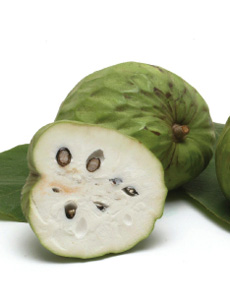PRODUCT: Fun With Cherimoya Fruit
|
What’s a cherimoya?
The heart-shaped subtropical fruit seems exotic because, depending on where you live, you may not come across it often. But seek it out: The tasty blend of mango, pineapple and strawberry flavors is worth it. Believed to have originated in the Andes Mountains, the name originates from the Quechua (Inca) word chirimuya, meaning “cold seeds” (because the seeds germinate at high altitudes). It grows as a shrub or tree. The pale green, shingled skin must be handled with care to avoid bruising. The ivory-colored flesh is creamy (similar to a ripe peach). Choose fruit that is firm and allow it to ripen at room temperature. As it ripens, the skin will turn a darker green and will yield to gentle pressure. Refrigerate soft fruit and use as soon as possible for best flavor. |
 A ripe, creamy cherimoya. Photo courtesy Melissas.com. |
|
|
To enjoy a cherimoya, all you need is a spoon. Cut the fruit in half or into wedges and spoon out flesh, discarding the seeds. The creamy, sweet flesh has earned cherimoya the nicknames ice cream fruit, sherbet fruit and custard apple. It’s easy to add tropical flair by including Cherimoya in desserts, fruit drinks and salads. Try these recipes for starters: One cup of cherimoya fruit has about 115 calories (11 ounces have about 300 calories). According to FoodScout.org, it has this impressive nutrition profile:
If you can’t find cherimoya fruit locally, you can order it online from Melissas.com. More of our favorite fruits. |
||


